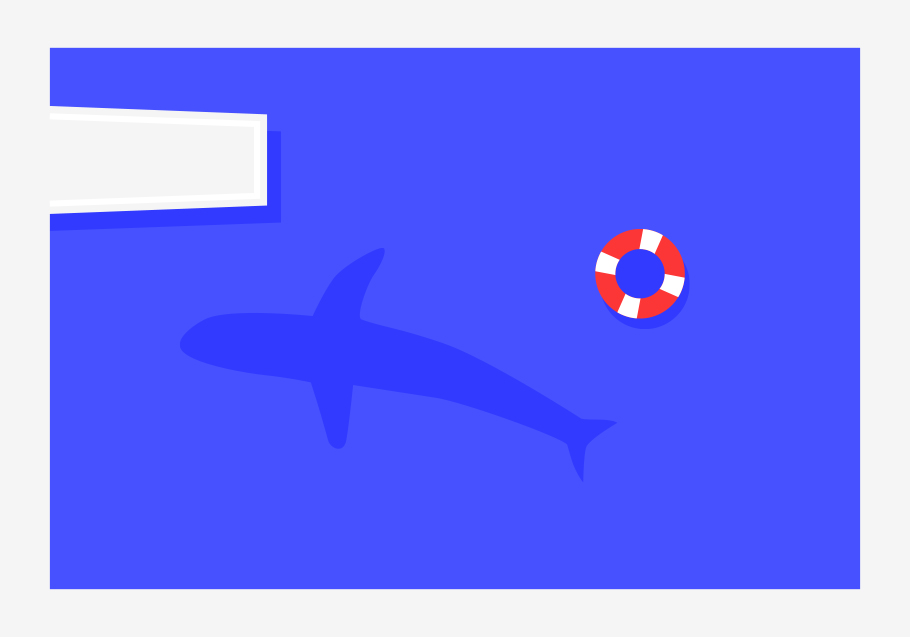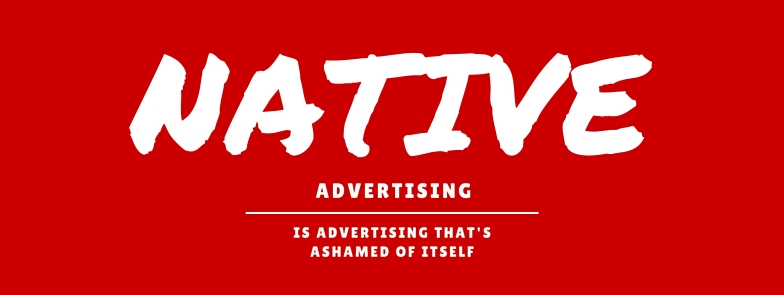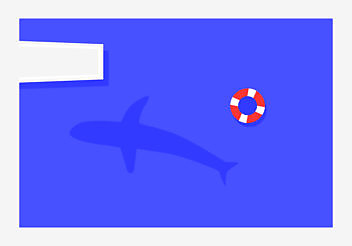
Let’s face it fellow marketers, we screwed it up pretty badly the first time around.
We made online advertising so bad, linking to content so useless, that people developed ‘banner blindness’.
In fact, ‘blindness’ is a euphemism: people aren’t blind to banners at all. We see them perfectly well. We just choose not to click on them.
We don’t click on them because we came to do something else, not to get sold to by a third party that has little do with the thing we came to do.
So how did the marketing industry and our publisher partners respond to the pitifully low click-through rates for our ads?
Did we improve the quality, relevance and utility of our marketing?
Did we make sure that, if we must interrupt our target audience, the least we can do is provide something they care about?
Did we get so clever and charming and useful that people got over their advertising apathy and developed ‘editorial blindness’ instead?
We did not.
That would be hard. (Marketers don’t like hard things.)
Instead, we invented Native Advertising.
Advertising that’s designed to look like exactly like editorial (or non-promotional social media posts).
So people would click on them not realizing that they’re actually ads.
And, if we really do our jobs well, they might read the entire piece without ever realizing they’re in Advertorial Land.

Job done. Consumer tricked. Content delivered.
(I ranted about this like a grizzled, ancient mariner in Native Advertising: Trust for Sale, and again in Native Advertising Apologists Miss The Point — if you’re into this kind of thing.)
But then, someone pointed out that people may not like being tricked into clicking an ad. That it might be just a tad unethical.
So how did the marketing industry respond to this little ethical issue?
Did we make our native ads look a bit less like editorial and a bit more like advertising?
Did we stop allowing native ads to use the house font and style sheet?
Did we separate out the native ads on clearly marked sections of our websites?
We did not. (That would, um, defeat the whole point).
Instead, we invented ‘disclosure’ and talked a lot about ‘transparency’.
Mostly, we experimented with disclosures that didn’t actually disclose anything at all.
With words like “Partner Content” or “Expert Network” or “From the web”.
And it worked perfectly.
By not working at all. (If ‘working’ means being clear and open).
A recent study in the Journal of Advertising called Going Native showed that only about 8% of consumers recognise that native ads are paid-for content.
Shocking, right? You’d almost be forgiven for thinking this was intentional.
Seeing that data, marketers responded by asking, “How can we do better?”.
More specifically, “How can we design even more effective disclosure statements that dupe the remaining 8%?”.
Which prompted regulators like the Federal Trade Commission to get interested. Their recently published Guidelines on Native Advertising are a small but solid step towards doing what we marketers should have done for ourselves. (Will Critchlow wrote an excellent analysis of the FTC rules in this post on Moz called A Checklist for Native Advertising: How To Comply With the FCC’s New Rules.)
So here’s the thing.
Maybe this whole native advertising thing is a chance for us marketers to get it right this time.
Maybe instead of using these ill-gotten clicks to push things like, “The Secret to Great Abs Without Exercising or Dieting”, we can promote smart, fun, entertaining, useful content that’s actually relevant to the reader.
Maybe we can start training people that those weird, quasi-editorial things are generally really good.
Then maybe we won’t have to hide our agenda and can actually be entirely open about it – real transparency instead of the fake kind.
Basically, me and my old-fashioned ilk (people who value editorial independence as the single most important thing in our media sources) have pretty much lost.
Native is the new banner.
If we get it wrong, we’ll all be fretting about ‘native ad blindness’.
If we get it right, people might think, “Oh cool: content from Audi on that thing I care about. Click.”
I guess I’m saying let’s put more effort into delivering valuable marketing to our prospects so we can spend less effort tricking them into viewing it.
I guess I’m saying let’s not screw it up this time.

Enjoyed this article?
Take part in the discussion








Comments
Ryan Forrester February 17th, 2016
Nice post, Doug.
If you take a broad view of the thing, there’s not that much difference between an in-feed ad that pops up in your FB feed (or other feeds) between every dozen or so updates, and a 30s TV spot that popped in commercial breaks for network sitcoms. At least that’s how I see it.
And, just as there were shiitty TV spots (some product-focused, some brand storytelling-focused), there will be shitty in-feed native ads (some product-focused, some brand storytelling-focused). It will all come down to the sophistication, luck and focus of the marketer and his agency.
In other words: I expect to see a lot of shitty native ads. I expect to see a number of great ones. And they’ll be blocked or victims of ‘blindness’ in the same way TV spots were always blocked – people looked at other stuff instead. Skipped. Etc.
Doug Kessler February 17th, 2016
All good points, Ryan.
I do think a lot of native ads are different from TV ads.
Zero percent of TV viewers ever think the ads are the program. They know they’re sponsored.
But only 8% of consumers know that native ads are sponsored content. (No accident).
So native is more like undeclared product placements in our TV shows or news programs.
The native posts on social feeds are a bit more obvious than the stuff that hides on sites like The Guardian, The New York Times, Forbes, etc (the ones you would have sworn would be the very last to sell their souls, not the first).
My favourite disclosure statement is from The Onion: “There’s a stone where our soul once was. This is sponsored content.”
Adan B2B Marketing February 17th, 2016
Ryan, you may see native ads as similar to TV advertising, and that’s fair enough. But the people on the other end of the screen probably do not.
The first thing about all advertising space online nowadays is that it’s typically invaded something that used to be cool. Facebook, Twitter, buzzfeed, Linkedin, whatever- these were all things designed to be cool and for people to fall in love with them, become dependent on them- and then for the ad men to come in and slowly but surely pull the rug out from underneath them and hope nobody notices. Historically, sites have jumped the shark, users have jumped ship to the next cool site, and the cat and mouse game lives on.
The second issue is that of Active and Passive participation- you sit in front of a tv and wait to see what it provides for you. Online, you are hunting for the things you want. By definition, ads are impediments to your goal. That’s why content marketing works when done well- it’s marketing that helps people complete their mission, and they’ll love you for it. That mission could be some big B2B project (fun), or it could just be 30 seconds of distraction from the joy-vacuum that a rainy London in February can be on a Wednesday at 4:45.
Doug Kessler February 17th, 2016
You can chart the arrival of the marketers on every cool platform that starts ad-free.
I thought Ello might be a warning shot for Facebook. It spiked on the ‘no ads ever’ promise. Then disappeared forever before any Zuckerberg anywhere lost any sleep.
Shame.